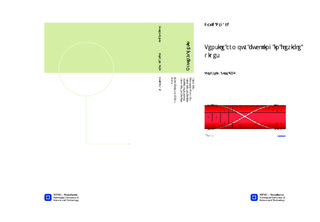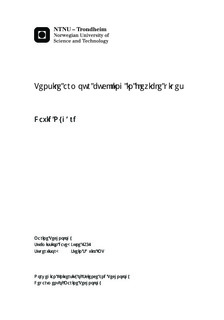| dc.contributor.advisor | Sævik, Svein | nb_NO |
| dc.contributor.author | Nygård, David | nb_NO |
| dc.date.accessioned | 2014-12-19T12:08:17Z | |
| dc.date.available | 2014-12-19T12:08:17Z | |
| dc.date.created | 2012-11-08 | nb_NO |
| dc.date.issued | 2012 | nb_NO |
| dc.identifier | 566158 | nb_NO |
| dc.identifier | ntnudaim:7612 | nb_NO |
| dc.identifier.uri | http://hdl.handle.net/11250/238269 | |
| dc.description.abstract | The exible pipelines has been widely used by the oil and gas industry the lastdecades and this trend is expected to continue as the operating depths are increasedfurther. For deep water applications the radial and lateral buckling modes can becritical. Many studies has been carried out using nite element models to studythese failure modes.In this thesis a nite element model is created with the aim to recreate resultsobtained in a recently published article by Vaz and Rizzo. The model is built upusing pipe, beam, contact and spring elements to represent the complex behaviourof the cross section. The loading is carried out by rst applying the dry mass, thenthe external pressure and nally end compression.When comparing buckling loads generated in this thesis by the ones in thearticle by Vaz and Rizzo the observation made is that the buckling loads from thisthesis are signicantly higher. When comparing only the inclination of the endshortening versus buckling load curves it was seen that the curves from article hada only slightly larger inclination than the results from the analyses in this thesis.This indicates that there is a small dierence in the stiness used. By modifyingthe stiness it should be possible to get the same inclination of the curve.Analyses were also carried out on how the slip distance aects the bucklingloads. By increasing the slip distance by 50% and 100% it was observed thatthe buckling loads were reduced drastically. In the article by Vaz and Rizzo noinformation is given on the slip distance. By tuning the slip distance and stinessof the springs it should therefore by possible to obtain the exact same results as inthe article. This clearly illustrates the importance of stating all assumptions andinput parameters when describing models used for analysis. | nb_NO |
| dc.language | eng | nb_NO |
| dc.publisher | Institutt for marin teknikk | nb_NO |
| dc.subject | ntnudaim:7612 | no_NO |
| dc.subject | MTMART Marin teknikk | no_NO |
| dc.subject | Marin konstruksjonsteknikk | no_NO |
| dc.title | Tensile armour buckling in flexible pipes | nb_NO |
| dc.type | Master thesis | nb_NO |
| dc.source.pagenumber | 111 | nb_NO |
| dc.contributor.department | Norges teknisk-naturvitenskapelige universitet, Fakultet for ingeniørvitenskap og teknologi, Institutt for marin teknikk | nb_NO |

